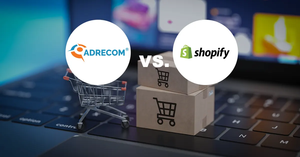
In the world of developer’s and consultants supplying software to commercial clients, there have always been core issues which dictate the choice of one software solution over another. In the world of website development — more specifically eCommerce — the “core issues” which were once so numerous have now taken on a new wavelength - that of the open vs closed source software solution. What this article will set out to accomplish is to convey a more current understanding of the choices clients are evaluating and see if there is a 3rd alternative that can bridge the gap between the poles of what is currently seen as the only two choices.
Open source e-commerce software which includes branded platforms like Magento, ZenCart or OS Commerce enable site owners to have full access to the source code of the software so that they may modify any part of the website for a particular need. Don’t assume this means it’s easy to do by the way, it just means that if you are concerned about having access to extend functionality in the platform or modify a design template or make changes to the database (behind the scenes), nothing is hidden from you. And whether this means you personally with internal resources or your hired guns (developers and programmers) need access, you will have it.
As long as you have a developer or web programmer who knows how to modify the code then at least you have the access you need and this feeling of access is like having a swimming pool in your backyard that you never use but it was still worth it just to know you could take a swim without driving to the beach or public pool. Magento is an example of a well-known open-source e-commerce platform that was purchased by Ebay previously and has enjoyed a significant mass adoption because developers feel — as they do with most open source systems — that they can tweak and adjust its source code for a variety of needs.
When you think of an open source solution though, you almost instantly are inspired to think about its polar opposite which is colloquially referred to as a “Proprietary (closed)” software solution. In this spectrum, closed software is akin to the notion of the black box where fundamentally something inside the software coding is simply blocked from any access save the developers of the software (or master licensees). Most changes to proprietary software are accomplished by the software creator or in some cases, if the right level of access is granted, then the changes may still even require approval by the original vendor.
As this article unfolds, the reader is invited to keep his/her eyes open for the introduction of a middle ground e-commerce solution called “Open Access” whose purpose is to bridge the gap between the benefits and detriments of open and closed solutions. In the world view of an Open Access solution, though some part of the source code is closed off, a significant part of the software engine is not only available but promoted to developers and other coders so they can have the access they enjoy 95% of the time in open source solutions but still sacrifice the 5% in favor of the Open Access software vendor.
Before presenting the case to bridge the gap, we must first isolate and highlight what are the key differences and shared goals between both sets of open and closed solutions in the marketplace. Our hope is that by doing a thorough review of the pros and cons of what is currently available we should be able to see what opportunities exist for a 3rd type of solution that can also achieve better ROI (return on investment) under the “Total Cost of Ownership” (TCO) analysis usually conducted when choosing between an open source product versus a proprietary one.
The first step in our review process is to present a classification system to “chunkify” the data in terms of priorities and relevance to each other. When we speak of TCO, the idea is to look at the cost of integrating a solution (whether open or closed or otherwise) and then managing the solution (i.e. the website) over the short and long term period of time. It’s fairly easy to say that labor costs are one of the top “costs” and we describe such costs as being “tangible direct costs.” Compare the cost of labor to something less quantifiable like the “user experience” and quickly one realizes that there are many disparate layers to the TCO analysis. With that in mind, we can still start with a baseline set of categories.
In
a review by Forrester, they laid out five core views
on open source solutions that are commonly held by eBusiness professionals
(which they have dubbed “promises”):
Promise No. 1: Open source software is less costly.
Promise No. 2: The same important core eCommerce features that I need are
there.
Promise No. 3: I have more flexibility with open source.
Promise No. 4: I can leverage a community to drive innovation.
Promise No. 5: It will be easier to access resources and do so at a lower cost.
Let’s talk about customization of the Solution and 3rd Party Apps:
One of the critical priorities for managing the growth of your website is the ability to modify how the site looks and how it functions. In simpler terms you want to be able to control either what comes out of the box or what is deployed with your custom delivered website. If any part of your website access is locked so that the site can’t grow (with your own labor resources) as your business needs grow, this is a not a situation your CIO or CTO wants to advocate.
Closed source obviously cuts off access to the base code, but it isn’t black and white. Many companies will permit some code modification if you remain communicative and follow guidelines. In terms of brand-new functionality, you’re placing your trust with the platform’s developers; if they’re speedy and conscientious, advancements can come along fairly often. It all depends on the originators.
Here is where an open source technology offers an advantage because in most cases you can customize the solution to fit your exact needs either at deployment or down the line. In a closed source case, you may have the same ability to customize the system but you will have to pay the software vendor or approved developer a fee to do so. A developer or programmer can access the source code and help a business make the modifications that need to be done in order for the software to work for your particular business. With closed solutions it is often the case that the source code vendor has to make the modifications and without the relationship of trust, customers often feel blackmailed and that their hands are tied and they are at the mercy of the developers. This is a challenge we readily acknowledge closed source solution vendors have to deal with daily.
Now this leads to an often quite convincing argument in favor of still using a closed source vendor. If you have found a vendor that has been in business for let’s say at least a decade, then what you have really is a consistent provider that frees you from the risk of attrition that happens when your internal staff experiences turnover in the ordinary course of business. There is serious financial and time risk when you have to invest in your internal staffing and invest in documenting all the procedures only to find that every two years you have new people manning the store (who have to be brought up to speed). Whereas in the case of vendors you work with year after year — even in a proprietary solution — they are investing in the labor cost and assuming the risk of attrition and turnover. And, in the case of solid vendors, you will be oblivious to their internal turnover as they continue to maintain high standards of performance that brought you to their doorstep in the first place. Obviously you have to weigh the cost of what you are paying a vendor as compared to your total cost of paying internal staff and this is where TCO comes into play because the goodwill benefits of having a continuous service provider minding your store may be worth more than the comfort of having access that maybe you don’t really need (thought you want it).
Note that there are companies that build a base open source platform and allow other 3rd party companies and people to build additional functionality on top of their platform. This can help you get more features and capabilities from your open source solution and potentially lowers the amount of time and money you need to spend on customizing your system. When your open source e-commerce solution vendor releases updates to their platform, these usually contain changes to security vulnerabilities which should be implemented in a timely manner. These "upgrades" can have issues working with 3rd party modules or "apps" that you might have installed previously causing more time for your development staff or having to bring in expensive consultants.
How much support do I really need?
In most cases, open source solutions offer little to no direct support unless you are willing to pay for it. This is normally how the company makes their money. They do provide a searchable message board or knowledge base where you can search through posted questions and answers but for one-on-one response it will cost time and money. The developers will likely charge substantial rates per incident or require you to be on some kind of monthly or yearly support contract. In either case, this is an important factor to consider. Take note that your closed source provider will also have a maintenance/support plan. The point is to not be surprised that in the open source case you will also have to pay even if you didn’t expect to.




